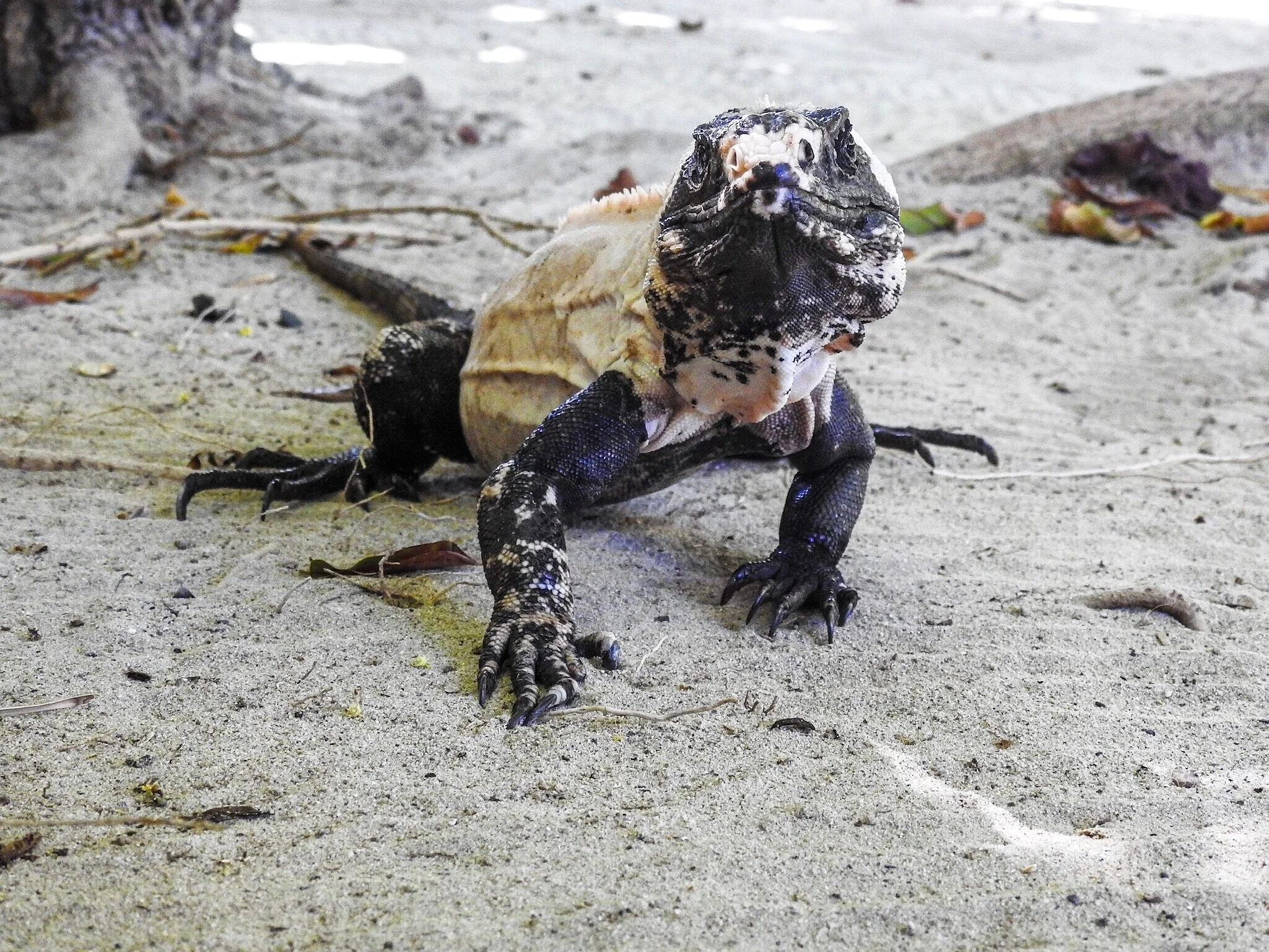
A True Roatan Native.
The Black Iguana.
Did you know that the Spiny-tailed Iguanas are only found on the island of Roatán?
Roatan spiny-tailed iguana or “garrobo” (Ctenosaura oedirhina de Queiroz 1987), are an endemic species of Roatan, and some small surrounding cays, located in the Bay Islands of Honduras. It is a species of a reptile of the genus Ctenosaura. This species was described in 1987 (de Queiroz) by Kevin de Queiroz when it was split from the sister taxon Ctenosaura bakeri found on the island of Utila, Honduras, and was given the species name “oedirhina” because of its rounded snout.
Endangered Status.
The Black Iguana species is listed as Endangered by the IUCN Red List Assessment and under Appendix II of Convention on International Trade of Endangered Species of Wild Fauna and Flora. The factors that contribute to the decline of these iguanas and habitat destruction are associated with urban development, small-scale agriculture, pet trade, and food exploitation. Another contributor comes by way of illegal hunting of iguanas for human consumption. Conservation measures must focus on alleviating threats to harvesting and habitat destruction through increased law enforcement and education.
Habitat.
The black Iguanas of Roatan are found in all habitat types across the island includes mangroves, tropical wet forests, and rocky shorelines and urban areas as well. However, due to the hunting pressure, they are found in privately protected areas across the island, tourist centers, and ecological parks. These iguanas easily adapt to anthropogenically disturbed areas as long as they are not exposed to animals such as cats and dogs and people who want to hunt them down. Approximately 4,500 iguanas live on the island, the vast majority live in protected areas, and less than 1% of iguanas live outside these protected areas and are exposed to hunting.
Characteristics.
These iguanas are recognized for their black color with dark gray stripes. They have a more rounded snout because of their nasal capsule are inflated. Their vent snout size is up to 12.75 inches, that of males is generally longer and heavier than females. Spiny-tailed iguanas, as the name implies, have a tail covered with spines that they use to defend themselves, despite this, they are more likely to flee if there is a predator nearby.
Their bodies are slim with brown and black stripes. Male iguanas have a large flap of skin under their chin, called the dewlap. A thin row of flat spines covers the back of both sexes. Spiny-tailed iguanas are primarily active during the day when the temperatures are warm. These iguanas are semi-arboreal, as they spend time in trees and rest in hollow trees. Females leave the nest after laying their eggs, and around 90 days later, the new hatchlings leave the nest independently. The black Iguanas diet consists of plant species, non-vegetative items, including hatchling peacock turtle (trachemys venusta), birds, crabs, ants, flies, and their shed skin.
Conservation Organization.
An organization that supports the conservation of this species on the island of Roatan is called IIF (International Iguana Foundation). This non-profit organization seeks to ensure the survival of iguana species around the Caribbean, promoting habitat protection, education, scientific research, and captive management. The IIF began funding projects for Roatan Spiny-tailed Iguanas. Research funded by this organization has focused on collecting life history and basic natural information about this species. The mission of IIF is to protect iguanas and their habitat through scientific programs and generate public awareness of the threats these iguanas are facing, the critical role they play in maintaining healthy ecosystems, and restore endangered iguanas through science-based conservation actions.
Other Iguana Species on Roatan.
This is not the only species you will find on Roatan. Seven species of iguanas have been described in Honduras; only one belongs to the genus Iguana, which is popularly known as green iguana, whose scientific name - and there is no mistake in repeating it - is Iguana iguana. The other six correspond to the genus Ctenosaura and are generally considered as black iguanas.
There is a great diversity of Iguanas that you can find on Roatan. The island has several tourist attractions where you can see the different species. Gumbalimba Park is one of them, as well as Arch's Iguana and Marine Park. Arch's Park is home to around 3,500 iguanas of four different species, especially the green iguanas.
Green Iguana.
The green iguana is a large arboreal lizard from Central and South America found on the Caribbean islands. They measure up to 2 meters in length from head to tail and can weigh more than 15 kilograms. The green color of their skin allows them to blend perfectly with the vegetation in their environment, although in Honduras, adult males can take on a pale color. Its skin is covered with small scales; they have a dorsal ridge that runs from its head to its tail. These animals feed on fruits, vegetables, and green leaves.
The other six species belong to the genus Ctenosaura and are grouped as black iguanas, although the color does not predominate in all iguanas. They are all oviparous. All the Ctenosaura (except the bakeri) present at birth an intense green color that could be mistaken with a green iguana. However, the green iguana is differentiated by its thick rounded scale near the mouth and smooth tail.
Currently, these iguanas are one of the main ecotourism attractions on the island. Tourists and visitors who come to the island will have the opportunity to appreciate this exotic species if they visit one of the parks. Everyone should know the importance of protecting the most vulnerable species in Roatán, as well as the natural habitats where they grow.



